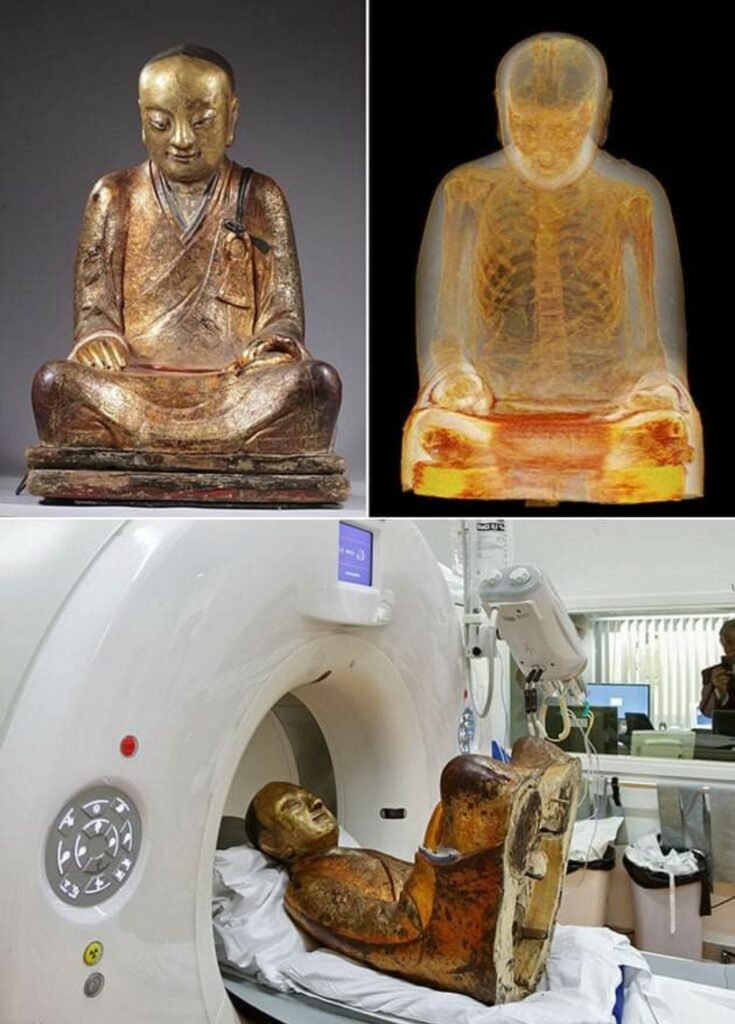A Surprising Discovery Unveiled by Modern Technology
In an astonishing blend of art, spirituality, and scientific progress, a CT scan of an ancient Buddha statue from China revealed an unexpected secret—the mummified remains of an 11th-century Buddhist monk. This remarkable find at the Drents Museum in the Netherlands has captured the attention of researchers, historians, and spiritual seekers alike, offering deep insights into the religious practices and mummification methods of ancient Buddhists.

The Mysterious Statue and Its Concealed Occupant
The Buddha statue in question stands at an impressive 1.2 meters and is embellished with gold-painted papier-mâché. Previously part of a private collection, it was loaned to the museum, where few could have imagined that hidden within its tranquil and contemplative form was an astonishing secret—the mummified remains of a monk, positioned in the iconic lotus posture.

The Journey to Self-Mummification: Sokushinbutsu

The mummified remains illustrate the rigorous ascetic practice known as “sokushinbutsu,” or self-mummification, undertaken by certain Buddhist monks in Japan and China from the 11th to the 19th centuries. This challenging path to Buddhahood involved several stages:
Preparation and Fasting
Initially, the monk would follow a strict diet, subsisting solely on nuts, seeds, and berries to eliminate body fat, a process that could take several years.
Dietary Restrictions and Preservation
As the diet became increasingly limited, the monk would eventually consume a toxic tea made from urushi tree sap, which acted as a preservative while eliminating bacteria and parasites that could lead to decay.
Seclusion, Meditation, and the Final Breath
The monk would then withdraw into a stone tomb, barely larger than their body, where they would sit in the lotus position and meditate until death. A small air tube provided breathing access, and a bell would be rung to indicate their continued existence. When the bell stopped ringing, the air tube was removed, and the tomb was sealed.

Mummification and Enshrinement
After several years, the tomb would be opened to assess the condition of the body. If it was well-preserved, the monk would be enshrined and honored as a “Living Buddha.”
Scientific Discoveries and Cultural Importance
Utilizing advanced imaging techniques and endoscopic examinations, researchers gained valuable insights into the mummified remains and their historical context. The monk’s internal organs had been removed and replaced with paper scraps inscribed with Chinese characters, likely containing prayers or religious texts. DNA analysis and carbon dating further verified the age of the remains, confirming they date back to the 11th century.

Honoring History with Dignity
This discovery not only enhances our understanding of Buddhist history and rituals but also prompts ethical considerations regarding the treatment and display of human remains. The Drents Museum has been meticulous in ensuring that the exhibit is presented with the highest respect and dignity, providing context that honors the monk’s sacrifice and spiritual journey.
As people around the globe marvel at this extraordinary revelation, it serves as a poignant reminder of the lasting impact of spiritual devotion through the ages, as well as the remarkable insights that emerge from the intersection of art, science, and cultural inquiry.

